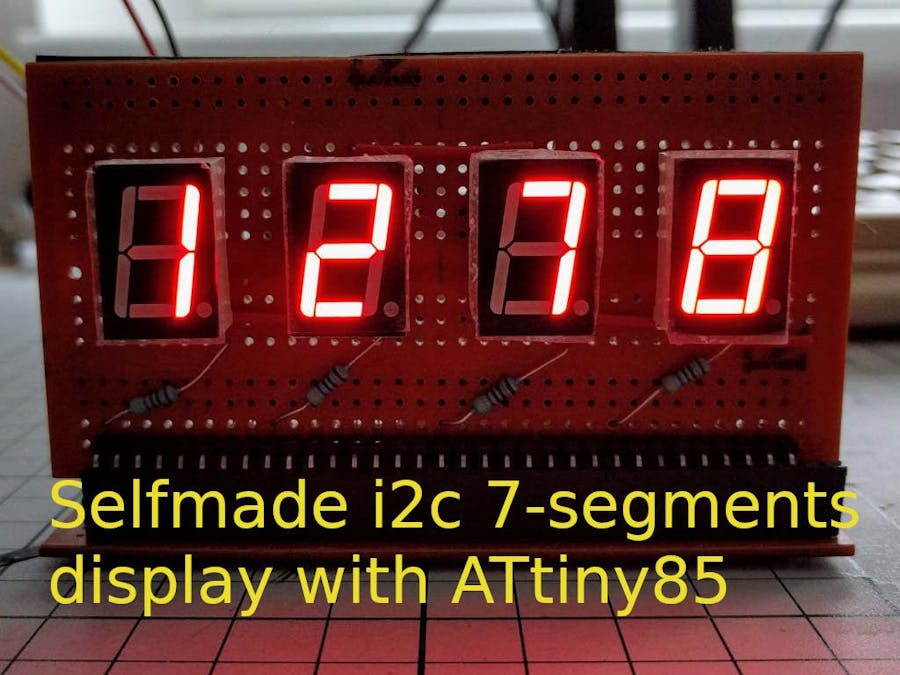Because I had a bunch of common anode 7-segment displays I decided learn how to make I2C slave device.
Originally published on https://taunoerik.art/portfolio/selfmade-i2c-7-segments-display-with-attiny85/
1. 7-segment LEDsMy 7-segment LEDs are marked as 5611BH and looks like this:
I connected four 7-segment displays together on PCB and I added resistors (470Ω).
I use 74HC595 shift registers to drive 7-segment LEDs.
Example master (Arduino Uno or Nano) code:
#include
int output = 1234;
void setup() {
Wire.begin(); // join i2c bus
Serial.begin(9600);
}
void loop() {
byte iiii = (output/1000) % 10; // == 1
byte iii = (output/100) % 10; // == 2
byte ii = (output/10) % 10; // == 3
byte i = output % 10; // == 4
Wire.beginTransmission(10); // transmit to device #10
Wire.write(iiii); // sends one byte
Wire.write(iii);
Wire.write(ii);
Wire.write(i);
Wire.endTransmission(); // stop transmitting
Serial.println(output);
Serial.println(iiii);
Serial.println(iii);
Serial.println(ii);
Serial.println(i);
output++;
delay(1000);
if(output > 9999){
output = 0001;
}
} //loop end
Look my tutorial: Programming ATtiny85 with Arduino Uno
Download and install TinyWire libary: https://github.com/lucullusTheOnly/TinyWire
7. Slave codeExample slave (ATtiny85) code:
/*
* Chip: ATtiny85
* ATtiny85 as i2c Slave Receiver
* Date: 23.12.2018
* Author: Tauno Erik
*/
#include
byte own_address = 10; //Slave i2c address
// Arduino uno: latch 8, data 11, clock 12
// ATtiny PB1, PB3, PB4
int latchPin = 1; // Pin connected to ST_CP of 74HC595
int dataPin = 3; // Pin connected to DS of 74HC595
int clockPin = 4; // Pin connected to SH_CP of 74HC595
// Array holds digits 0-9
byte numArray[11];
uint8_t i = 0;
uint8_t ii = 0;
uint8_t iii = 0;
uint8_t iiii = 0;
void setup() {
// Setup TinyWire I2C slave
TinyWire.begin( own_address );
// Sets callback for the event of a slave receive
TinyWire.onReceive( onI2CReceive );
// Set pins to output because they are addressed in the main loop
pinMode(latchPin, OUTPUT);
/*
* 7-segment LED:
* |--A--|
* F B
* |--G--|
* E C
* |--D--|
* H
*
* GF+AB
* #
* ED+CH
*
* 0b00000000
* ABCDEFGH
*
* 0- High! (Common anode!)
* 1- Low
*/
numArray[0] = 0b00000011;
numArray[1] = 0b10011111;
numArray[2] = 0b00100101;
numArray[3] = 0b00001101;
numArray[4] = 0b10011001;
numArray[5] = 0b01001001;
numArray[6] = 0b01000001;
numArray[7] = 0b00011111;
numArray[8] = 0b00000001;
numArray[9] = 0b00001001;
numArray[10] = 0b11111111; // all off
digitalWrite(latchPin, 0);
shiftOut(dataPin, clockPin, 0b11111110);
shiftOut(dataPin, clockPin, 0b11111110);
shiftOut(dataPin, clockPin, 0b11111110);
shiftOut(dataPin, clockPin, 0b11111110);
digitalWrite(latchPin, 1);
delay(400);
} //setup end
void loop() {
} //loop end
/**********************************************************************
* I2C Slave Receive Callback:
* Note that this function is called from an interrupt routine and shouldn't
* take long to execute
**********************************************************************/
void onI2CReceive(int howMany){
digitalWrite(latchPin, 0);
//while(TinyWire.available()>0){
while(1 < TinyWire.available()){
int c = TinyWire.read();
shiftOut(dataPin, clockPin, numArray[c]);
}
//lastone
int x = TinyWire.read();
shiftOut(dataPin, clockPin, numArray[x]);
digitalWrite(latchPin, 1);
}
/********************************
*
********************************/
void numsOut(int i, int ii, int iii, int iiii){
digitalWrite(latchPin, 0);
shiftOut(dataPin, clockPin, numArray[iiii]); //0xxx
shiftOut(dataPin, clockPin, numArray[iii]); //x0xx
shiftOut(dataPin, clockPin, numArray[ii]); //xx0x
shiftOut(dataPin, clockPin, numArray[i]); //xxx0
digitalWrite(latchPin, 1);
}
/*************************************
*
*************************************/
void shiftOut(int myDataPin, int myClockPin, byte myDataOut) {
// This shifts 8 bits out MSB first,
// on the rising edge of the clock,
// clock idles low
//internal function setup
int i=0;
int pinState;
pinMode(myClockPin, OUTPUT);
pinMode(myDataPin, OUTPUT);
//clear everything out just in case to
//prepare shift register for bit shifting
digitalWrite(myDataPin, 0);
digitalWrite(myClockPin, 0);
//for each bit in the byte myDataOut�
//NOTICE THAT WE ARE COUNTING DOWN in our for loop
//This means that %00000001 or "1" will go through such
//that it will be pin Q0 that lights.
for (i=7; i>=0; i--) {
digitalWrite(myClockPin, 0);
//if the value passed to myDataOut and a bitmask result
// true then... so if we are at i=6 and our value is
// %11010100 it would the code compares it to %01000000
// and proceeds to set pinState to 1.
if ( myDataOut & (1<<i) ) {
pinState= 1;
}
else {
pinState= 0;
}
//Sets the pin to HIGH or LOW depending on pinState
digitalWrite(myDataPin, pinState);
//register shifts bits on upstroke of clock pin
digitalWrite(myClockPin, 1);
//zero the data pin after shift to prevent bleed through
digitalWrite(myDataPin, 0);
}
//stop shifting
digitalWrite(myClockPin, 0);
}












Comments
Please log in or sign up to comment.